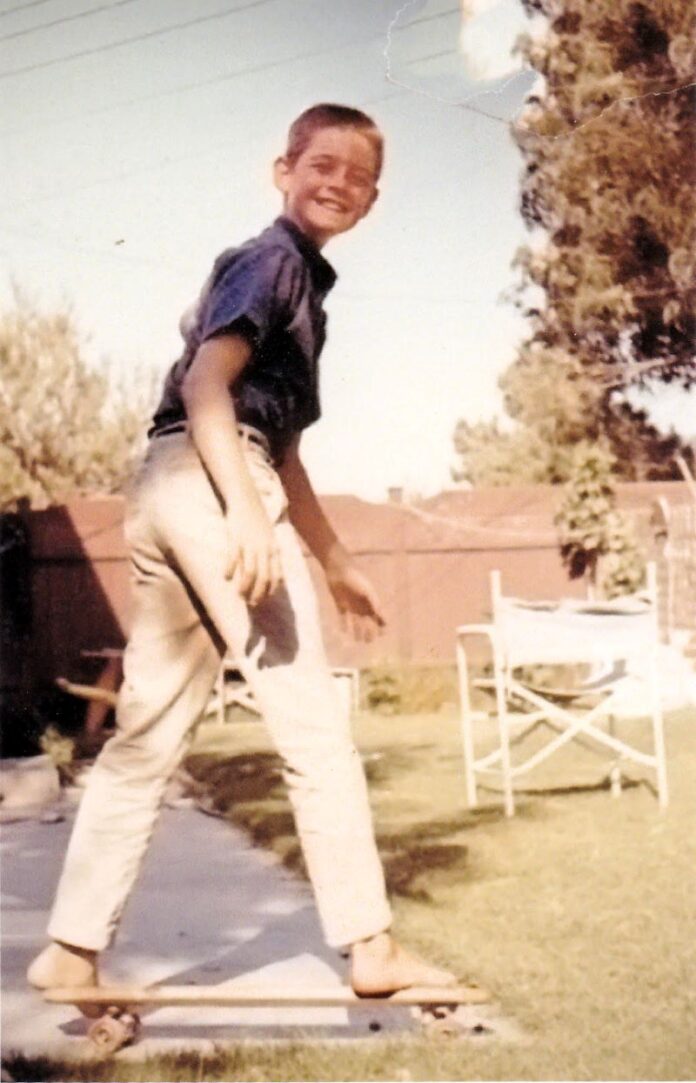Oceanside, CA –The California Surf Museum is proud to present this inaugural event to be held at Oceanside’s Veterans Association of North County acknowledging those who helped launch what became a worldwide phenomenon at a time when the development of surfing and skateboarding were deeply entwined.
“At the dawn of the 1960s, when the waves were flat, surfers were skateboarding,” says Jim Kempton, Executive Director of the California Surf Museum in making the announcement. “Skateboarding at the time was the ‘boom within the boom’ as interest in both surfing and skateboarding skyrocketed. A development in one informed and advanced the other. It will be great to step back in time and salute these early years and those who helped make it happen, long before surfing and skateboarding would ascend to become Olympic sports.”
Several celebrity guests expected to be in attendance include original member of the Z-Boys Club and 1977 Men’s World Overall Championships winner Tony Alva and John Freis, first place overall winner at the 1965 Anaheim Nationals and member of the Skateboarding Hall of Fame. Proceeds from the “Rolling from the 60s into the 70s” event supports the work of the California Surf Museum and the Skateboarding Hall of Fame. Tickets for the event are $75. For more information visit surfmuseum.org.
The event kicks off at 4 P.M. with cocktails, a silent auction, dinner and the highlight of the evening, presentation of the inaugural “Silver Skater Award” to six honorees. This award is presented by the California Surf Museum to a skateboarder who has made significant contributions to the culture, evolution and support of the skateboard community and whose life has also inspired others to expand their awareness and continue to set a shining example of a true Silver Skater.
The inaugural Silver Skater Award honorees are:
Dean Torrence
Though Dean Torrence and Jan Berry had grown up playing music together, it would be 1959 when they would begin to record music as the duo forever known as “Jan and Dean.” Playing gigs with another breakout group of the time, The Beach Boys, introduced them to “the surf sound” that would come to brand their style and music as well. Between 1959-1966, they registered twenty-six Billboard and Cash Box chart hits.
Among them was a song that celebrated the synergy between surfing the waves and another emerging form. “Don’t be afraid to try the newest sport around… Grab your board and go sidewalk surfin’ with me,” they sang out.
Originally released in 1964, “Sidewalk Surfin” would be successfully reissued as a single 12 years later and by the 1970s new lyrics were being added to keep up with the latest tricks and jargon. Today it remains a skateboarding anthem and reminder of that era. In addition to his musical achievements, Torrence majored in advertising design in the school of architecture at USC and has enjoyed an impressive career as a graphic artist and designer of numerous classic record album covers. In 1996, Jan and Dean were inducted into the Hollywood Rock Walk of Fame.
Larry Stevenson
Larry Stevenson is considered by many as “the father of the skateboard.” A former lifeguard and publisher of Surf Guide magazine, in 1963 he created Makaha Skateboards in a belief that skateboarding naturally meshed with surfing culture and that his magazine could be a platform in promoting it. In the fall of 1963, Makaha sponsored the first skateboard contest, drawing nearly 100 competitors to the Hermosa Beach, California event. Makaha also was the first company to sponsor a skateboard team to travel around and give exhibitions and became one of the first skateboard companies to make a professional signature model, in this instance for the surf star Oceanside, California’s Phil Edwards. By 1965, as the skateboard culture flourished, he was selling upward of 2,000 boards a day. Stevenson passed away in March 2012 at the age of 81 in Santa Monica, California, following a long battle with Parkinson’s disease.
Herbie Fletcher
Before Herbie Fletcher founded Herbie Fletcher surfboards and started Astrodeck, he was chasing down big waves on the North Shore on his jet ski, or was even a surfer, he was a skateboarder. As reported by Wavelength magazine, there is a 1963 photograph of young Herbie dropping into an empty backyard swimming pool on his skateboard. The image is now recognized as “the earliest example of pool skating, captured a full decade before the Dog Town crew took up the mantle,” they write. By the age of 14, he was making skateboards, cut out in the shape of a surfboard, in wood shop at school. In the 1970s, he was designing and making skateboards along with the surfboards he was shaping and making at his surf shop. Growing up, he also holds the distinction of being a member of both the Hobie Surf and Hobie Skateboard teams.
Michael Mel
“Skaterdater,” an 18-minute short subject film first released in 1965, continues to be considered by many as the most acclaimed movie in the history of skateboarding. Among the adolescent cast ranging in age from 13 to 15, was then 13-year-old Michael Mel a member of the Imperial Skateboarding Club who would emerge as the star of the show. Among the boy-meets-girl plot was lots of skating, a cool original soundtrack played out against a Southern California South Bay backdrop, but not a word of dialogue. “Since there was no dialog in the movie, we had to figure out from what we were shooting what the story was,” the now 60-something Mel explains in a 2017 interview that ran in the Torrance Daily Breeze. “It wasn’t until I saw the finished movie that I got the whole thing. Mostly we were into skateboarding, and we were always trying to insert tricks into the action.” In 1965, Mel went on to rack up wins in skateboarding contests such as the South Bay Skateboard Championship and the under-14 division of the Santa Monica Surf Festival.
“Skaterdater,” which was shot on a budget of $9,000, was nominated for Best Short Subject (Live Action) at the 1966 Academy Awards and won the Palme d’Or for Best Short Film Technical Grand Prize at the 1966 Cannes Film Festival. The genius behind it all, filmmaker Noal Black, passed away in 2014.
Tom “Wart” Craig
Some will tell you that since 1949 “Surf City” has been the official name of a small town in North Carolina. But by the 1960s, it was a name being widely applied to Hermosa Beach, California. As home of the first recognized skateboarding competition, the title “Skate City” could also aptly apply. And one young Hermosa-born surfer/skater named Tom “Wart” Craig was making a name for himself in both areas. In 1963, twelve-year-old Tom took first place in a Valley Vista skateboarding event and next took home first place in the second year of Larry Stevenson’s annual skateboard contest at Hermosa’s Pier Avenue School. Tom also became one of the charter members of the South Bay Skateboard Club and was soon named to Bing Copeland’s skateboard team. In 1964, he was featured in the first edition of the new quarterly magazine, Skateboarder. In 1966, he became a member of Bing’s famed surf team, further cementing a close relationship with Bing that continues to this day.
In 1958 he began collecting surfing and skating memorabilia preserving items that chronicle the development of both sports and formed the Surfing Heritage – A Save a Log Foundation. At the age of 73, he remains active as a surfer and skater.
Frank Nasworthy
Frank Nasworthy was drawn to relocate to Southern California from Northern Virginia in 1971 as a young college age guy intent on focusing on riding its legendary waves. He soon found himself rising to “big wheel” status based on a simple land-based observation. He found that his Hobie skateboard could function much better once he replaced its clay composite wheels with the soft polyurethane wheels found back home being used by the local skate rinks. This switch provided a smoother ride that was fast and controllable and ultimately paved the way for a second great boom of skateboarding that, by 1975, led to scores of manufacturers entering the market. By then, Nasworthy was selling 300,000 sets of wheels per year. A long-time Encinitas resident, Nasworthy officially retired in 2017. With a degree in Applied Mechanics from the University of California San Diego, Nasworthy has continued his interest in inventing and creating.
Link to Skaterdater (1965) | The World’s First Skateboard Movie
About the California Surf Museum
The California Surf Museum was founded in 1986 and has been in operation for nearly four decades serving tens of thousands of annual visitors from over 40 nations around the globe. With a permanent collection which chronicles the history of surfboards and wave-riding, the museum also offers many revolving exhibits each year. It has acquired a rare set of archives and collections gathered since its founding, comprising one of the world’s richest troves of surfing history. The California Surf Museum is a 501(c)(3) non-profit organization located at 312 Pier View Way, Oceanside, CA 92054; phone (760) 721-6876; email csm@surfmuseum.org. Please visit the website at surfmuseum.org. Open daily 10:00 a.m.-4:00 p.m.; closed major holidays and for special events.



















